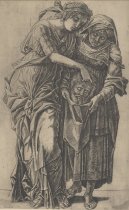Object Record
Images

Metadata
Catalog number |
P133 |
Artist 2 |
Mantegna, Andrea |
Title |
Judith with the Head of Holofernes |
Object Name |
Engraving |
Description |
This print illustrates the story from an Old Testament apocryphal story about Judith, a Jewish widow who saved her people from slavery and death by the Assyrian army. Gaining access to the tent of the enemy general Holofernes she took advantage of his drunken stupor, decapitated him and took his head back to her countrymen. Having lost their leader, the Assyrian army fled, and Israel was saved. Girolamo Mocetto (ca. 1470-after 1531), an Italian engraver, painter, and designer of stained glass, portrays Judith as remote, impassive, and unaware of the crime that she has just committed as she passes the head of Holofernes to her maidservant Abra. The artist emphasizes Judith's passive strength and downplays the dangerous power of female sexuality by placing her away from the scene of the crime, the tent, and the bed of the Assyrian general. In the Renaissance, Judith became an example of the strength of local people against tyrannical rule from afar. Like David, who became the symbol of the Florentine Republic, she appealed to the Florentines, who saw themselves as the underdog fighting a more powerful enemy, originally the Milanese. The young heroine also attracted elite women such as Isabella d'Este, Vittoria Colonna, and Catherine and Maria de' Medici. They commissioned works depicting Judith and other female heroines of antiquity from famous artists of their time such as Titian, Mantegna, and Leonardo da Vinci. Through their commissions, elite females felt autonomous, able to assert their own identities and power. Noblewomen related their accomplishments to the achievements of ancient heroines such as Judith, Lucretia, Portia, and Cleopatra who were praised for their courage, fortitude, and loyalty. Maria Murillo, in "SCHOLARS, EXPLORERS, PRIESTS, How the Renaissance Gave Us the Modern World," ex. cat. G -T M, Queens College, CUNY, February 2 - March 27, 2010, 33. |
Medium/Material |
Ink on paper |
Dimensions |
H-11.75 W-7.5 inches |
Year Range from |
1500 |
Year Range to |
1505 |
Search Terms |
Renaissance 15th century AD 16th century AD Devotional Portrait Death Narrative Judith Figure Biblical Religious Old Testament Italy Europe |
Exhibition and Publication History |
* "SCHOLARS, EXPLORERS, PRIESTS, How the Renaissance Gave Us the Modern World," Curated by James M. Saslow, G -T M, Queens College, CUNY, February 2 - March 27, 2010, # 33, ill. |
Culture |
Italian |

